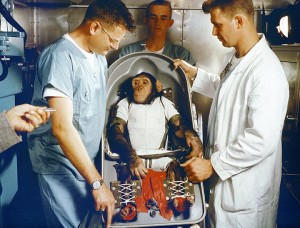Ham the Chimpanzee: Space Pioneer
When thinking of Project Mercury, students likely point to the first astronauts. Mercury was the first National Aeronautics and Space Administration (NASA) project to send humans into space. They were some of the first beings to traverse the stars aboard a rocket and orbit the Earth, but that’s not all. Primates are the group of animals that includes monkeys, apes, and human beings. The first primate in space wasn’t cosmonaut Yuri Gagarin—it was a brave chimpanzee named Ham.
Ham was one of several animals used in Project Mercury. The Mercury capsule was tested with chimps and other primates before launching humans into space. Chimpanzees were used because they are intelligent and closely related to humans, with the ability to be trained to perform simulated spacecraft operations. Ham helped to prepare the U.S. space program for human space flight.
Ham was born in the 1950’s in a forest in Cameroon (then French Cameroon). The U.S. Air Force had chimps captured from the forest and sent to the United States. In 1959, 40 chimps were enrolled in the “School for Space Chimps” on the Holloman Air Force Base in Alamagordo, New Mexico. They were given the nickname astrochimps and trained for spaceflight. Another astrochimp, Enos, later became the first and only chimpanzee to orbit Earth.
At just 3 years old, Ham, also known as Subject 65, excelled at his tasks. The nickname Ham stood for Holloman Aerospace Medical Center, where the chimps were trained. Ham learned to pull levers when cued by a blue light. The chimps were trained to spend long periods in a chair and were subjected to extreme acceleration forces and microgravity, the sensation of weightlessness experienced by astronauts in space. After 18 months, Ham and five other well-performing chimps were sent to Cape Canaveral, Florida, in 1961 for an experimental flight. The brief suborbital flight was to test the environmental controls, life support, and recovery systems of the Mercury spacecraft in weightless conditions.
On Jan. 31, 1961, a Mercury-Redstone 2 rocket took off with Ham as its passenger. He was strapped into a “couch” in the small, pressurized capsule. The craft briefly lost air pressure during the flight, but Ham’s capsule saved him from harm. The rocket traveled 400 miles (640 kilometers) and peaked around 160 miles (250 kilometers) above Earth’s surface. It went higher and faster than NASA’s plan, which called for a peak of 115 miles (185 kilometers) altitude and a top speed of 4,400 miles (7,000 kilometers) per hour. The rocket actually reached speeds of 5,800 miles (9,300 kilometers) per hour.
The flight lasted about 16 ½ minutes. Ham experienced 6 ½ minutes of weightlessness. Ham was dressed in a spacesuit and waterproof pants. He was hooked up to sensors that recorded his body temperature, breathing, and heart rate. The flight was probably extremely distressing to Ham. Despite the stress of weightlessness and crushing acceleration forces, Ham was able to pull levers in response to flashing blue lights. He proved that astronauts could perform motor functions under the stresses of spaceflight. His capsule splashed down in the ocean and was recovered 130 miles (210 kilometers) from its target. The capsule was taking on water, and Ham had been waiting in distress for hours.
After the flight, Ham was relocated to the National Zoological Park in Washington, D.C., in 1963. After 17 years living alone there, Ham joined other chimps at the North Carolina Zoo in Asheboro in 1980. Ham died on Jan. 18, 1983, at the age of 25, young for a chimp. His remains were buried by the U.S. Air Force at the International Space Hall of Fame in the Museum of Space History in Alamogordo. His skeleton was kept for scientific study at the National Museum of Health and Medicine in Washington D.C. NASA eventually stopped sending non-human primates into space in the 1990’s, in part due to pressure from animal rights groups.



